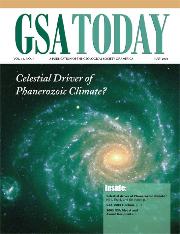Cosmic Rays as a Climate Driver: The Debate
[FONT="]Counter to claims by anthopogenic global warming enthusiasts, there is ample evidence to support the idea that cosmic rays do indeed affect climate (evidence will soon be summarized on this site).[/FONT]
[FONT="]
Cover of GSA Today - A geology magazine with a spiral galaxy on it. Some people didn't like it!
[/FONT]
[FONT="]Thus, it is no surprise that we find in our GSA Today paper ([/FONT][URL="http://www.gsajournals.org/pdfserv/10.1130%2F1052-5173%282003%29013%3C0004:CDOPC%3E2.0.CO%3B2"]External PDF[/URL][FONT="], [/FONT][URL="http://www.phys.huji.ac.il/~shaviv/Ice-ages/GSAToday.pdf"]local PDF[/URL][FONT="] or [/FONT][URL="http://www.gsajournals.org/gsaonline/?request=get-document&doi=10.1130%2F1052-5173%282003%29013%3C0004:CDOPC%3E2.0.CO%3B2"]HTML[/URL][FONT="]) that Cosmic Ray Flux variations appear to be the largest driver of climate change over geological time scales. However, one of the secondary conclusions we reach in the paper is that CO[/FONT][FONT="]2[/FONT][FONT="] had only a secondary climate role over geological time scales, and that Earth's sensitivity to changes in the radiation budget is not as large as most of the climate community believes (which ranges between 1.5 to 4.5°C temperature increase following a doubling of the atmospheric CO[/FONT][FONT="]2[/FONT][FONT="]). This of course, has various interesting ramifications, which is why our work attracted many assaults.[/FONT]
[FONT="]Two such assaults appeared in the scientific media, and as such should be addressed. Here we bring the unabridged rebuttal addressing each and every point raised.[/FONT]
[FONT="]Before continuing, note that once the climatic effect of cosmic rays is included in different [/FONT][URL="http://www.agu.org/pubs/crossref/2005/2004JA010866.shtml"]empirical sensitivity analyses[/URL][FONT="] based on different time scales as the analysis described in our GSA Today article, consistent sensitivities are then obtained. The consistent sensitivity range is between 1 to 1.5°C per CO[/FONT][FONT="]2[/FONT][FONT="] doubling. That is, empirical analyses on different time scales corroborates our GSA Today results regarding the climate sensitivity. . . . . [/FONT]

 en.wikipedia.org › wiki › Julian_Simon
en.wikipedia.org › wiki › Julian_Simon



